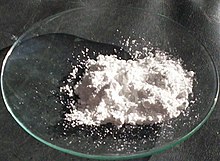Visual effects
Strong red colours for eye products have been produced using the dye carmine, made from carminic acid extracted form the crushed bodies of the cochineal insect.[citation needed] Carmine was once the only bright red color permitted by the FDA for use around the eye.[citation needed]
Pearlescence, also sometimes spelled as "pearl essence", is a shine or gloss effect commonly used in a wide variety of cosmetic products. The most usual source of pearlescence is the natural mineral mica covered by a thin layer of titanium dioxide. This coating causes goniochromism – the colour appears through interference effects with the naturally translucent mica, and varying the thickness of the titanium dioxide changes the colour.[3] Alternatives exist, including the suspension of tiny flakes of a suitable material within the product, often a wax such as glycol distearate. A shimmery substance found on fish scales, most usually obtained from herring and one of many by-products of commercial fish processing, can also be used for pearlescent effects, primarily in nail polish, but is now rarely used due to its high cost, bismuth oxychloride flakes being used as a substitute instead.[2]

